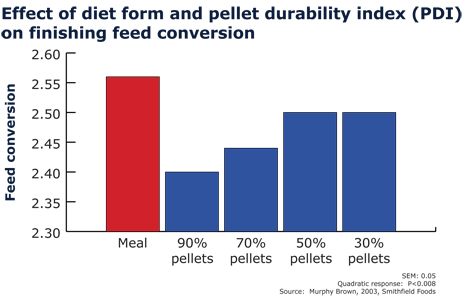
Pellets or meal? Which is better?
 By Julie Salyer
By Julie Salyer
Feeding pelleted diets to finishing pigs has been shown to improve feed conversion by 5 to 8 percent. High feed costs have led producers to re-evaluate the economics of feeding pellets in all phases of swine production. Some factors to take into consideration when contemplating whether to pellet swine diets include feed processing costs, factors including particle size and pellet quality, as well as the ingredients that can be used in formulation.
Particle size
Feed particle size has the potential to improve feed efficiency. The particle size of feed ingredients can be reduced to (<400 microns) when pelleting. In contrast, a typical meal feed particle size recommendation is 600 to 700 microns. Reducing the average particle size of ingredients within a pellet improves digestion and nutrient absorption. However, one precaution is that smaller feed particle size can potentially increase the risk of stomach ulcers. Additionally, the act of grinding to a finer particle size increases mill energy cost as grinding time lengthens, and increasing die thickness decreases through-put.
Pellet quality
Pellet quality has a huge impact on animal growth performance, as the amount of pellet fines can change the magnitude of growth response, sorting and feed wastage. Processing factors such as temperature, ingredient inclusion, die thickness, etc. have a significant impact on pellet quality. 
Byproducts
Byproducts are potential cost savers in swine diet formulations. It is, therefore, important to be aware of how these ingredients may affect pellet quality. For example, diets containing more than 7 percent fat probably won’t make good pellets; and diets containing more than 18 percent fiber will most likely not push through the pelleting die. However, including a limited amount of higher fiber ingredients, such as wheat middlings, can help bind ingredients and make stronger pellets. Two pelleting experiments were conducted by M.L. Potter et al., (2010) at Kansas State University. Experiment 1 evaluated the pelleting of corn-soybean meal-based diets, while experiment 2 evaluated the pelleting of diets containing multiple byproducts. Pelleting produced an improvement in growth performance in both experiments. However, more fines were observed at the feeder with the diets contained byproducts and, therefore, the magnitude of improvement in growth performance was lower compared to pigs fed the pelleted corn-soy diets.
Equipment investments
Purchase and installation cost is a significant factor for those who might consider installing their own pelleting system. For example, a 15 ton-per-hour pelleting system, including a new boiler, wiring, and 8 to 20 ton loadout bins, costs about $850,000. This investment only makes sense if a production system has enough through-put to optimally utilize the pelleting system. Other pork producers might take advantage of the benefits of pelleting by seeking out commercial toll mills with pelleting capabilities.
About the author: Julie Salyer previously provided technical support for Vita Plus field and sales staff and conducted nursery research trials as a swine nutritionist. Salyer received her bachelor’s degree at The Ohio State University and master’s degree in swine nutrition at Kansas State University. She is originally from southwest Ohio, where she raised and showed livestock for the county 4-H fair. She was also a student worker at Ohio State’s swine farm and completed an internship in North Carolina for Murphy Brown LLC, which she says was instrumental to where she is today. Salyer is active in church and enjoys hunting, kayaking, hiking and spending time with her husband, Brandon, and their two dogs.
| Category: |
Feed quality and nutrition Swine Performance |

